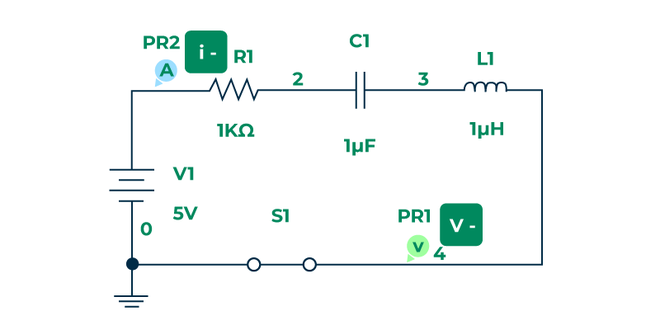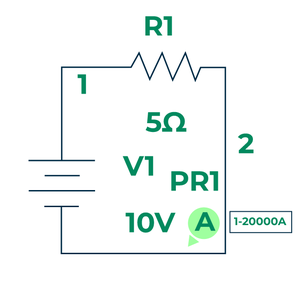Electronics and circuits go hand-in-hand, basically, every topic of electronic systems involves some explanation through basic circuits. In this article, we discuss how to represent an electronic circuit. We talk about the basic components required to make an electronic circuit, and the primary terminologies associated with them.
In this article we will be going through the Representation of an electronic Circuit, First, we will start our Article with what is an Electronic Circuit, we will see how an Electronic Circuit can be represented, Then we will go through the Different Components of Electronic Circuit Which are Divided into Active and Passive Components, At last, we will conclude our Articles with Advantages, Disadvantages, and FAQs.
We design a step-by-step guide for making an electronic circuit.
What is an Electronic Circuit?
Here we represent a simple electronic circuit consisting of a power source(battery), a passive device(bulb) , connecting wires and a switch.

Simple Electronic Circuit
Electronic circuit can be defined as a complete path for the flow of electricity or certain signal. It consist of individual elements like current source, conductors and loads which form an integral part of the circuit.
Inside an electronic circuit, electrons come out of the power source and travel along the conductor, pass through resistances performing some work against them and eventually returning back to source. A circuit can be linear or non-linear.
- Linear Circuit: A circuit in which current is directly proportional to applied voltage. Ohm’s law is valid for such circuits.
- Non Linear Circuit : A circuit which consist of non-linear elements like capacitors and diodes. This circuit will not have any linear relationship between the current & voltage.
Key Terminologies
- Electronic Circuit: An electronic circuit consists of electronic components like resistors, transistors, capacitors, and diodes which provide a complete path for current to flow.
- Power Supply: A power supply is a cell or group of cells that produces a direct current in a circuit by applying a DC voltage.
- Switch: This device completes the circuit. The ‘ON’ state indicates the circuit is complete and the ‘OFF’ state indicates the circuit is open.
- Connecting Wires: These are wires connecting the components of the circuit together.
Representation Of Electronic Circuit

Representation of Electronic Circuit
The above diagram is an electronic circuit whose circuit diagram is given on the right-hand side. In electronic circuit each device has a representation using certain symbols. The pictorial representation of various electrical devices in a circuit diagram is known as an electrical symbol.
Components Of Electronic Circuit
Components of circuit can be divided into two categories:
- Active Components: Active components are the devices that actively influence the circuit. The perform actions like amplification or rectification etc. They deliver or produce energy in form of Voltage or current. Examples of the active components are diodes, transistors, LED, integrated circuits, etc.
- Passive Components: These can be defined as the devices that provide passive functions like consuming or storing electrical energy. They utilize or store energy in the form of electric field or current. Examples of passive components are Transformer, Resistor, Switches, Voltmeter, Ammeter, Capacitor, and Inductor.
Try identifying the type of component from the components given below :
- Load
- Switch
- Connecting Wires
- Earth Ground
- Light Bulb
- Resistor
- Rheostat
- Potentiometer
- Capacitor
- Inductor
- Power Source
- Voltmeter
- Ammeter
- Diode
Load
An electrical load is an electrical component or portion of a circuit that consumes (active) electric power, such as electrical appliances and lights inside the home. The term may also refer to the power consumed by a circuit. In common household lights and bulbs are common examples of this.

Load
Switch
This device completes the circuit. The ‘ON’ state indicates the circuit is complete this means that the circuit is closed and ‘OFF’ state indicates circuit is open which is that circuit is incomplete. switch has an important use in changing the state of circuit while conducting the experiment . we should always turn the switch off after circuit has been used.

Switch
Connecting Wires
It is a flexible strand of wire or metallic conductor which provides a low resistance path for current to flow. These form an integral part in establishing the connections of the circuit. The connecting wires establish a connection between the circuit components. It is denoted by a straight line.

Connecting Wires
Earth Ground
The reference point in an electrical circuit from which voltages are measured thereby ground denotes 0 Voltage. While making a circuit our circuit should have a ground reference, for example in our households the plug-in board has an input hole connecting to the earth ground.

Earth Ground
Light Bulb
It is a device that consumes the current from the circuit. Depending upon its power rating, It converts electrical energy to heat and light energy. It is the most common load used in households. From this you can tell why light bulb is a passive device. There is a minimum power required to turn the bulb on.

Light Bulb
Resistor
It is the component of circuit which resists the flow of current in the circuit i.e. it offers some kind of resistance for electrons to flow .Some work is done by resistor in this process thereby generating heat. Excessive heat can damage the circuit so one should carefully choose the range of operation of the resistors being used in the circuit.

Resistor
Rheostat
It is a variable resistor whose resistance can be adjusted as per need. It has a knob which is used to increase or decrease the resistance offered. It is very useful for cases where we don’t know the exact value of resistance . This rheostat finds great application in experiments.

Rheostat
Potentiometer
A potentiometer is a three-terminal resistor with a sliding or rotating contact that forms an adjustable voltage divider. Two of the terminals are connected to the ends of a resistive load and the third terminal connects to a sliding contact which moves over the resistive element. It can be used to determine the emf and internal resistance of the given cell and also used to compare the emf of different cells.

Potentiometer
Capacitor
It is a device that stores electrical energy in form of electric field. When voltage is supplied to capacitor ,it begins to charge depending upon its time constant. The charge is stored on the capacitor in the form of an electric field until it is made to discharge using a resistor ,then the charge slowly begins to decay. It is a passive device.

Capacitor
Inductor
It is a two-terminal electrical component that stores energy in a magnetic field when electric current flows through it. It consist of an insulated wire coiled around a metal. Inductors are the devices that oppose any change current flowing through them. Inductors are also passive elements.

Inductor
Power Source
Usually a battery, power source is the device that supplies electric power. The integral component of circuit, it usually takes input in the form of electric power and converts it into voltage and current for circuit. The power from the power source is the major driving force of the circuit.
-200.png)
Power Source
Voltmeter
The voltmeter is an instrument for measuring electrical potential. It ids important to note that voltmeter is always connected in parallel across the component whose voltage is to be measured. The positive terminal and the negative terminal connections should be made correctly.

Voltmeter
Ammeter
The Ammeter is an instrument for measuring electric current. It is important to note that the ammeter is connected in series with the components across which the current has to be measured. It is an electronic instrument used for checking or testing of circuit in laboratories.

Ammeter
Diode
It is a device that allows flow of current in one direction only . It is a two terminal device that acts as a short in other direction. It has low (ideally zero) resistance in one direction and high (ideally infinite) resistance in the other. A diode is a passive element.

Diode
Steps To Draw An Electronic Circuit
- Note the various components of electronic circuits you have like capacitor, inductor, resistor, power supply.

Components
- Connect all the components using connecting wires and add a switch for opening and closing the circuit.
-660.png)
Connection
- Make sure that all the elements are connected with the right polarity.
- Use ohm’s law and other formulas to calculate theoretical values of various parameters like current.
- Apply ammeter and voltmeters to verify the theoretical and experimental values of the parameters.

Circuit Diagram
Advantages of Electronic Circuit
An electronic circuit has multiple advantages:
- Electronic circuits are an easy way of representing circuits involving many components. Thereby helping us work in an organized manner.
- Electronic circuits are highly accurate and thereby are used for their programmability.
- Designs made on electronic circuits can further be implemented on IC chips.
- They provide us great Reliability and Flexibility.
Disadvantages of Electronic Circuit
An electronic circuit has disadvantages like:
- They often involve complex circuitry and can be tiring.
- They cost of assembling all components and purchasing them can be quite expensive.
- They demand a lot of accuracy and precision. The whole circuit might be damaged due to some faults in the connections.
Applications of Electronic Circuit
- Electronic circuits are almost used everywhere including Mobiles, calculators and other devices.
- Modern Communication involves the use of electronic circuitry for performing modulation demodulation and other tasks.
- Analog and Digital Communication make the use of ADC( analog to digital convertors) that involves electronic circuits.
- Semiconductor industry and IC industries make use of electronic circuits.
- Modern Labs in various institutions use small-scale electronic circuits for concept building in students.
Examples of Electronic Circuit
Consider a circuit with a 5Ω resistor, a 10V battery source and a switch. Represent the circuit and measure the value of current.
Using ohm’s law V=IR
On putting values I=10/5= 2A

Circuit
Consider a circuit consisting of an inductor of 0.1 mL what value of capacitor should be added to the circuit so that the frequency of electronic circuit is 2/π ?
For an AC electronic circuit
ω=2πf
ω=4
ω=1/√LC
LC=1/16
On putting values
C=625 F
Conclusion
We have fully analyzed electronic circuits. We have studied what they are, what are they made of, what do they represent and what purposes can they serve. It is expected that the reader go through the examples and test their understanding on the subject. The scope of electronic circuits is huge and this exploration can never end. This article has covered the basic concepts to get you started on electronic circuits and understand the working of these circuits.
FAQs on Representation of an Electronic Circuit
What are Passive elements?
Passive elements are the elements that consume electrical energy in an electronic circuit.
What is an AC electronic circuit?
An AC circuit consist an AC battery, a resistor, an inductor and a capacitor. The electric quantities in AC circuit have a varying magnitude and phase.
What kind of circuits are used in household and industries?
Generally, AC electronic circuits are used for industrial purposes.
Share your thoughts in the comments
Please Login to comment...